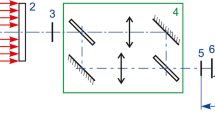Abstract
This article examines an algorithm for the computer analysis of holographic interference fringes of cylindrical shells in a three-hologram, double-exposure experiment conducted to study displacements. The method, based on graphical input of the coordinates of reference points on lines of equal order and approximation of order surfaces on the basis of regression analysis, makes it possible to formalize selection of the type of nonlinear mathematical model and speed up subsequent calculations. The statistical characteristics of the model and the regression process improve with an increase in the number of points. An analysis is made of the accuracy of the analysis of holographic interference fringes by the proposed method using the example of results of tests of a cylindrical shell with a nonplanar end in uniaxial compression. Satisfactory agreement is seen between data obtained by the proposed method and the traditional method.
Similar content being viewed by others
Literature cited
V. I. Mossakovskii, V. V. Petrov, A. G. Grinevskii, et al., Investigation of Shells by Holographic Interferometry (Survey) [in Russian], Submitted to VINITI 16.11.79, No. 39 00-79, Dnepropetrovsk (1979).
A. B. Kudrin and V. G. Bakhtin, Applied Holography (Investigation of Processes in the Deformation of Metals) [in Russian], Metallurgiya, Moscow (1988).
J. West, Holographic Interferometry [Russian translation], Mir, Moscow (1982).
A. G. Kozachok, Holographic Methods of Investigation in Experimental Mechanics [in Russian], Mashinostroenie, Moscow (1984).
A. M. Mil'tsyn and V. I. Olevskii, “Analysis of the accuracy of a mathematical model in the form of a seconddegree polynomial obtained from linearized data,” Submitted to VINITI 08.09.86. No. 6546-B86, Dnepropetrovsk (1986).
V. I. Mossakovskii, V. S. Gudramovich, and E. M. Makeev, Contact Problems of the Theory of Shells and Rods [in Russian], Mashinostroenie, Moscow (1978).
E. V. Binkevich and V. L. Krasovskii, “Experimental study of the stability of cylindrical shells in nonuniform compression,” Proceedings of the VIII All-Union Conference on the Theory of Plates and Shells, Nauka, Moscow (1973), pp. 246–249.
V. L. Krasovskii, “Effect of loading area on the stability of smooth cylindrical shells compressed by longitudinal local forces along segments of a guide ring,” in: Solution of Certain Physicotechnical Problems [in Russian], Dnepropetrovsk Un-t, Dnepropetrovsk (1972).
Author information
Authors and Affiliations
Additional information
Translated from Problemy Prochnosti, No. 5, pp. 78–85, May, 1994.
Rights and permissions
About this article
Cite this article
Mossakovskii, V.I., Mil'tsyn, A.M., Selivanov, Y.M. et al. Automating the analysis of results of a holographic experiment. Strength Mater 26, 385–391 (1994). https://doi.org/10.1007/BF02207425
Received:
Issue Date:
DOI: https://doi.org/10.1007/BF02207425



